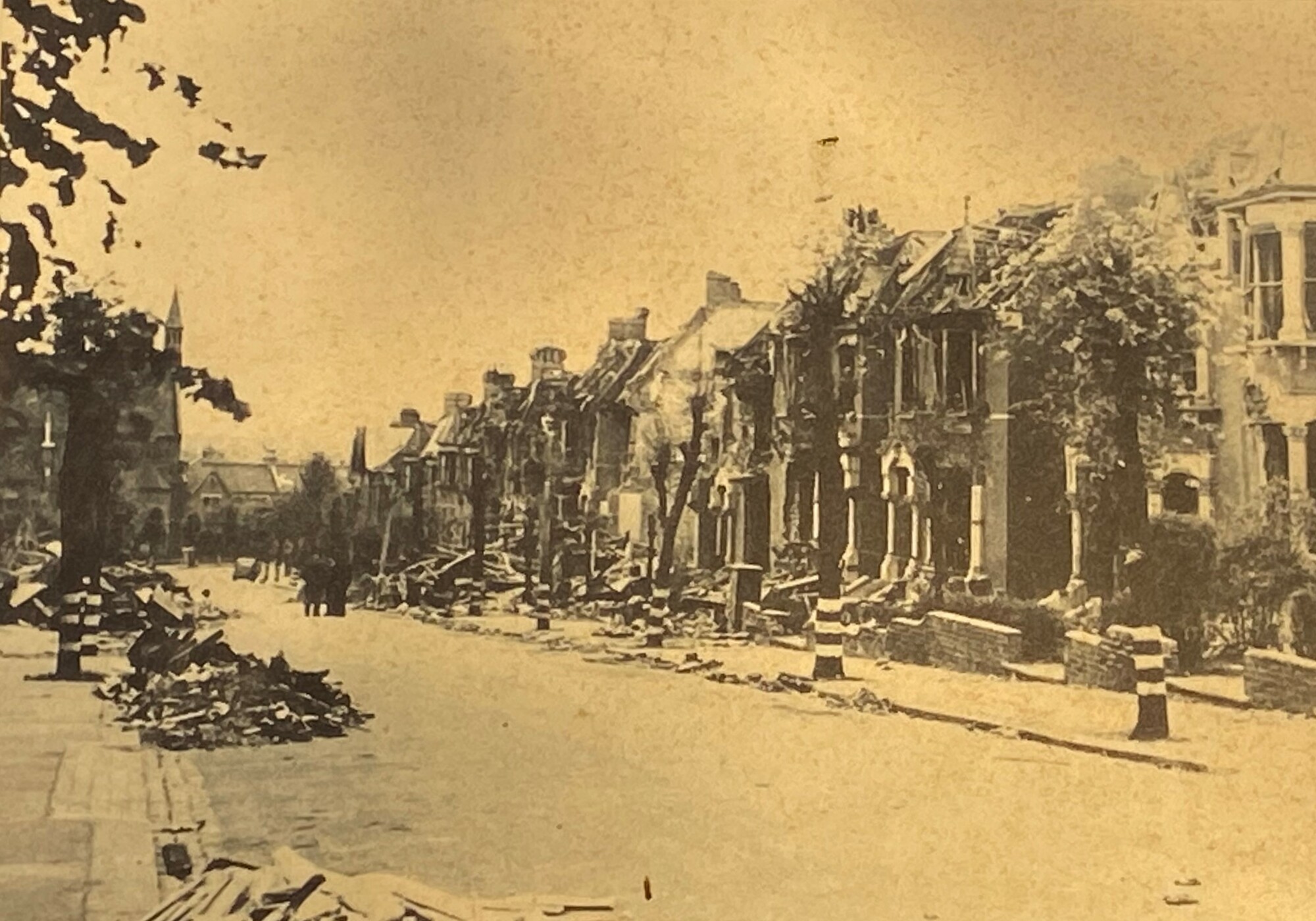Erection date: 27/3/2011
Early in the morning of Sunday 16 July 1944 a V-1 flying bomb fell on Granville Road, killing 15 people and seriously injuring 25 others. Twelve houses were destroyed; 100 others were damaged; Holy Trinity church, was badly damaged.
This Peace Garden commemorates the event, the people who died, and the reconstruction of the area in peacetime.
Those who died that morning in Granville Road: {See Subjects commemorated for the list of 15 names, listed by house number.}
The church’s windows and doors were blown out and there was a large hole in the roof above the organ, but Father Connerton asked that any tarpaulins be used first on people’s houses rather than the church. The church hall was already used as a rest centre for people who had been bombed out. Thirty-two people stayed there in bunk beds until they could be housed elsewhere.
In 1946 nineteen Arcon Mark V ‘prefab’ factory-built bungalows were erected on the Granville Road bombsite. Clad with corrugated asbestos cement, each was pre-wired, came with ducted air heating and had two bedrooms and a fitted kitchen including a refrigerator. They had a modern and compact look. Designed to last for 10 years, they actually stood until 1980. Local people remember prize-winning front gardens, including one with a fishpond.
In the 1980s the prefabs were replaced by new housing on the east side of Granville Road and, after a campaign by local residents, the Spinney wildlife area on the west side.
Holy Trinity Church (architect E. B. Ferrey) was consecrated in 1881 when the area was developed as a north London suburb, and took its place amongst other similar parishes in the rapidly growing city with its own loyal and active worshippers. In 1913 a church hall (architect J. S. Alder) was added. {This is the building to the left of our photo.}
The 1944 bomb damage proved so severe that in 1950 the church building was declared unsafe. Parishioners moved the alter and other fittings, including the organ, into the church hall, and a chapel was created in the vicarage. The church was pulled down in 1960 and a Service of Dedication in 1961, led by the Bishop of London, established a new place of worship in the former church hall.
In the same year a new vicarage was built on the site of the old church and this garden was leased to the council, with the World War One memorial as a centre-piece. The old vicarage was demolished to make way for St Aidan’s School, {to the north-east on Albany Road} opened by the Queen in December 1972. The memorial was destroyed by a falling tree in the gale of 1987.
The terrazzo and cobbles at the edge of this Peace Garden mark the entrance to the old church. A post from a washing line, hidden deep in the Spinney, is a trace of the people who lived in the prefabs. This garden is a memorial to those who died.
Thanks to Stroud Green Residents Association, Holy Trinity Church, Bruce Castle Museum (Haringey Culture, Libraries & Learning), Hornsey Historical Society, London Metropolitan Archives and the local people who researched and contributed to this board. Funded by Neighbourhood Management, Making the Difference Fund, March 2011. Haringey Council
Site: Holy Trinity Stroud Green (3 memorials)
N4, Granville Road, Holy Trinity church garden
This Peace Garden, opened on 27 March 2011, commemorates the 1944 V1 bomb, the people who died, the church that was destroyed and the subsequent reconstruction of the area.
Something here doesn't make sense. The info board talks of a single bomb which destroyed 12 houses and the church, and killed people in Granville Road at numbers 22, 24, 26, 28, 30, and 33. These are all further north up Granville Road, mainly on the east side, opposite what is now The Spinney. Between these houses and the church there were (and still are) 9 other houses, plus the church hall, none of which suffered any significant, if any, damage. Surely there must have been two bombs: one on the houses and one on the church.
At the Spinney another information board refers to one bomb destroying the houses, with no mention of the church. It includes this text: "The land where Granville Road Spinney now sits has seen many changes over the last 130 years. After being used as farmland until the 1870s, it was built upon when the railway came to North London. In July 1944 during World War II, a V1 flying bomb destroyed seven Victorian houses on the western side of Granville Road. These were replaced by Prefabs that were removed in 1980 and the area reverted back to open land." So this is talking about a single bomb which destroyed 7 houses on the west side, where the Spinney now is.















